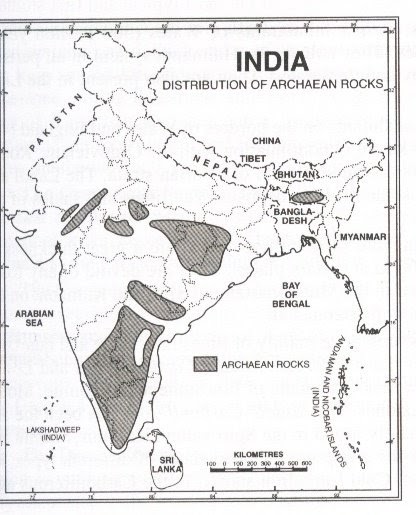
Rock System in India: One of the most important topics in Indian geography. Many questions are being asked from this section.
What is the Application of Studying geological history of India?
Study of Geological structure helps us in:
- Land use planning.
- Development of transport and communication lines.
- Increasing potential for irrigation.
- Determining the quality and quantity of ground water.
- Understanding natural disasters like earthquake, Tsunami, flood etc.
Hence before studying the geography of India it is very important that we first understand and study the geology of India.
India represent the assemblage of rocks of different character belonging to different ages.
Hence According to Sir T. Holland Indian rock system can be classified into following four divisions:
| Sr. No | Types | Period on Geological Timescale |
|---|---|---|
| 01 | The Archaean Rock System | Early Precambrian Eon |
| 02 | The Purana Rock System | Late Precambrian (Proterozoic Eon) |
| 03 | The Dravidian Rock System | 600-400 mya (Coinciding with Palaeozoic) |
| 04 | The Aryan Rock System | 400 mya (present time) |

Lets us understand one by one in details.
1. Archaean Rock System (Pre-Cambrian Rocks)
- Rocks formed prior to the Cambrian system.
- The word “Archean” was first coined by J. D. Dana.
These are the oldest in the world. These rock groups include the following rock groups:
Archaean Gneisses and Schists (4000 Million years old)
- First rocks formed at the time of cooling and solidification of Earth’s surface.
- They are all azoic, thoroughly crystalline and have a well defined foliated structure.
- Also known as “Basement” or “Fundamental Complex” since they forms the base for new layers.
- Gneiss: most commonly found. found in mineral composition. And may vary from granite to gabro.
- Also possesses a constant more or less foliated or banded structure.
- Schists: mostly crystalline, include mica, talc, hornblende, chlorite, etc.

Fig: Distribution of Archaean Rocks in India:
Dharwar System (1000 to 4000 Million years old)
Why the name Dharwar?
- Rocks first studied in Dharwar district of Karnataka, where such rocks are found in Abundance.
- Dharwar include both sedimentary and igneous origin rocks.
- The major rocks of Dharwar system are hornblende, schists, quartzite, phyllite slates, crystalline limestone and dolomites
- Dharwar are said to be most precious rocks system economically because they possesses valuable minerals like high grade iron ore, manganese, copper, lead, gold, quartzite, slates etc.
- These are first metamorphic sedimentary rocks in India.
Places where they found:
Aravali, Tamil Nadu, ChotaNagpur plateau, Meghalaya, Delhi, Himalayas.
Champion series rocks: containing gold mines lie within this system. this champion system is named after the champion reef in the Kolar Gold Field (KGF) one of the deepest coal mines in the world.
Remember this using this Movie:

Other series of Dharwar rocks system:
Champion series: Found Near Baroda. Sources of Lush green variety of Marbles.
Closepet series: Found in Balaghat and Chindwada region of MP. They are rich in copper ore.
Chilpi series: found in and around Closepet series of Balaghat and Chindwada.
Iron ore series: Found in Singhbum and Mayurbhanj and Keojhar ranges.
2. Purana Rock System (600 to 1400 million years old)
- Includes two divisions: the Cuddapah System and the Vindhyan System.
Cuddapah System
- When sedimentary rose like sandstone, limestone and clay were deposited in synclinal folds between two mountain ranges.
- Found mainly in Cuddapah region of Andhra Pradesh.
- Also found in Delhi, Rajasthan, Chattisgarh and lesser Himalayas.
- These rocks contain ores of iron, manganese, copper, cobalt, nickel, etc.
- They contain large deposits of cement grade limestones.
- They are rich in Metamorphic rocks such as shale, slate, quartzite etc. Even though metallic minerals like iron ore were found they were of poor quality.
Vindhyan System
- This system derives its name from the great Vindhyan mountains.
- The system comprises of ancient sedimentary rocks (4000 m thick) superimposed on the Archaean base.
- They are mostly unfossiliferous.
- A large area of this belt is covered by the Deccan Traps.
- The Vindhyan system have diamond bearing regions from which Panna and Golconda diamonds have been mined.
- It is devoid of metalliferous minerals but provides large quantities of durable stones, ornamental stones, limestone, pure glassmaking sand etc.
- The evidences of fissile microorganism’s found in these structures.
- These structures is famous for house boilings rocks like Sanchi Stupa, Red Fort, Jama Masjeed Etc built with red sandstone of this structure.
3. Dravidian Rock System (Palaeozoic)
- Came into force around 600 – 300 million years ago.
- Found in the extra-Peninsular region (the Himalayas and Ganga plain) and are very rare in Peninsular India. (The name ‘Dravidian’ doesn’t mean they are found in South India)
- They are sedimentary rocks, and abundant fossils can be found in them.
- The rocks of Cambrian, Ordovician, Silurian, Devonian and Carboniferous periods fall under the Dravidiansystem.
Cambrian rocks (600 million years)
- Named after Cambria Latin name of Wales in Great Britain.
- These Include slate, clays, quartzites and limestones.
- Best developed in North-west Himalayan region.
- In the spiti valley of Himachal Prades, there is an extensive found named as Haimanta System.
Carboniferous rocks (350 million years)
- The Carboniferous rocks (350 million years) comprise mainly of limestone, shale and quartzite.
- Mount Everest is composed of Upper Carboniferous limestones.
- Coal formation started in the Carboniferous age.
- Carboniferous in geology means coal bearing. (most of the coal found in India is not of the Carboniferous period; High-quality coal of Great Lakes Region-USA, U.K and Ruhr region is Carboniferous coal).
4. Aryan Rock System
- Upper Carboniferous to the Recent.
Gondwana System
- The Gondwana System (derives its name Gonds, tribes from Telangana and Andhra Pradesh)
- Constist of Sandstone with some shades of Clays.
- They are deposits laid down in synclinal troughs on ancient plateau surface.
- As the sediments accumulated, the loaded troughs subsided.
- Freshwater and sediments accumulated in these trough and terrestrial plants and animals thrived.
- This happened since the Permian period (250 million years ago).
- Main Areas: Peninsular areas along Damodar Valley in Jharkhand, Mahanadi river valley in Chattisgarh and Odisha and also in south part of MP.
Gondwana Coal
- Gondwana rocks contain nearly 98 per cent of India’s coal reserves.
- Gondwana coal is much younger than the Carboniferous coal, and hence its carbon content is low.
- They have rich deposits of iron ore, copper, uranium and antimony.
- Sandstones, slates and conglomerates are used as building materials.
Jurassic System
- The marine transgression in the latter part of the Jurassic gave rise to a thick series of shallow water deposits in Rajasthan and in Kutch.
- Coral limestone, sandstone, conglomerates and shales occur in Kutch.
- Another transgression on the east coast of the Peninsula is found between Guntur and Rajahmundry.
Deccan Trap
- The volcanic outburst over a vast area of Peninsular India from the end of the Cretaceous till the beginning of the Eocene gave rise to Deccan Traps.
- Basaltic lava flowed out of fissures covering a vast area of about ten lakh km2.
- These volcanic deposits have a flat top and steep sides and therefore called ‘trap’ meaning a ‘stair’ or ‘step’ in Swedish.
- The process of weathering and erosion (denudation) since millions of years has reduced the Deccan Trap to almost half of its original size.
- At present Deccan Traps covers about 5 lakh km2 mainly in parts of Kutch, Saurashtra, Maharashtra, the Malwa plateau and northern Karnataka.
- The thickness of the Deccan Traps is 3,000 metres along the west which is reduced to 600-800 metres towards the south, 800 metres in Kutch and only 150 metres at the eastern limit.
- The weathering of these rocks for a long time has given birth to black cotton soil known as regur.
The Deccan Trap has been divided into three groups:
| Group | Found in | Inter-trappean beds | Layers of volcanic ash |
| The Upper Trap | Maharashtra and Saurashtra | Present | Present |
| The Middle Trap | Central India and Malwa | Very rare to absent | Present |
| The Lower Trap | Madhya Pradesh | Present | Very rare to absent |
| In basaltic volcanism (Deccan traps, Siberian shield, Laurentian shield), some sediments settle on the cooled and solidified basaltic layer. This sediment layer is covered further by basaltic volcanism and again some sediments settle over it. These successive layers of sediments separated by the basalt are called inter-trappean beds. |
Tertiary System
- Formed between Eocene to Pliocene (60 to 7 million years ago).
- The tertiary is the most significant period in India’s geological history because the Himalayas were born, and India’s present form came into being in this period.
Credit Sources/References
More Topics on Geography:
| Rock System | Indo-Gangatic Brahmaputra plain |
| Himalayan Ranges | Peninsular Plateau |
| Coastline of India | Indian Islands |
| Drainage system of India | Indian Monsoon |
| Indian Climate | Natural Vegetation of India |